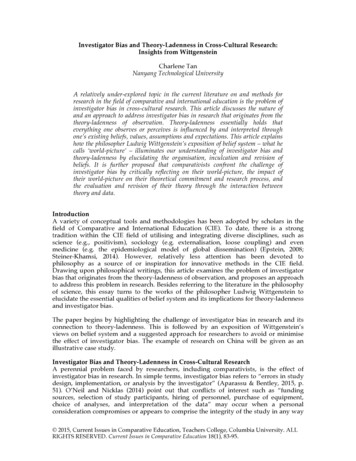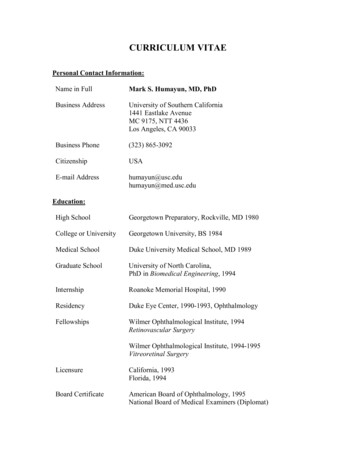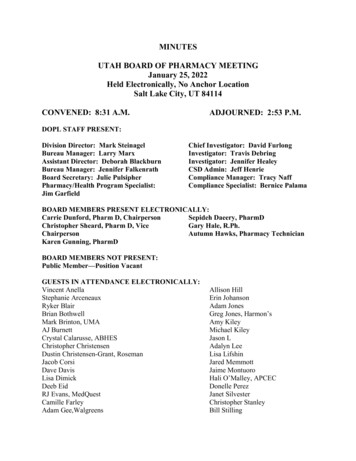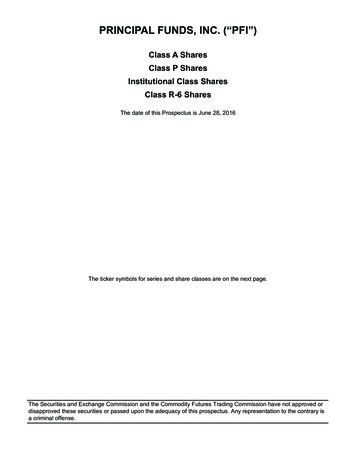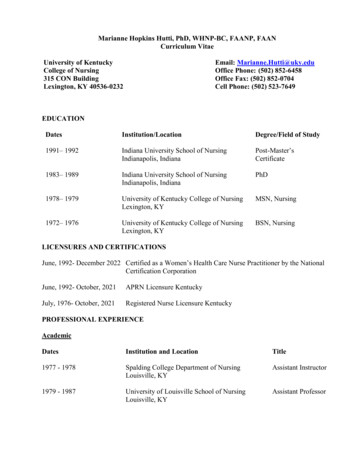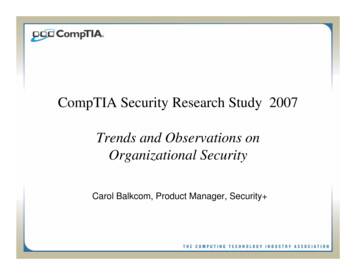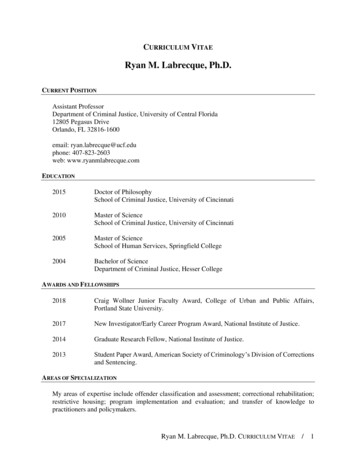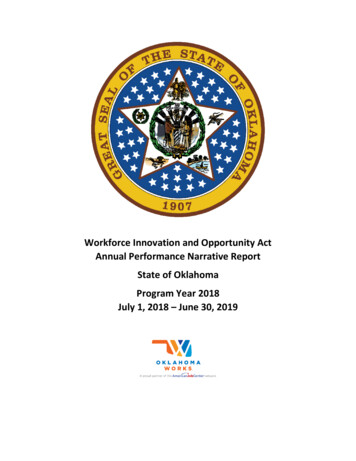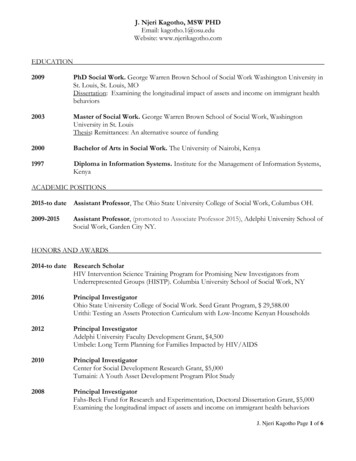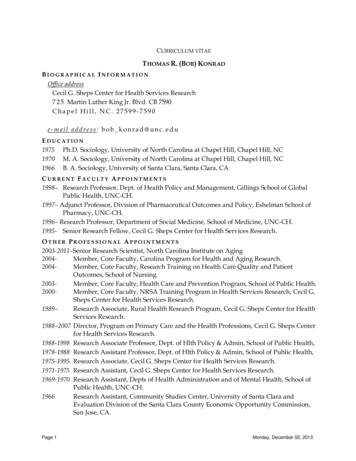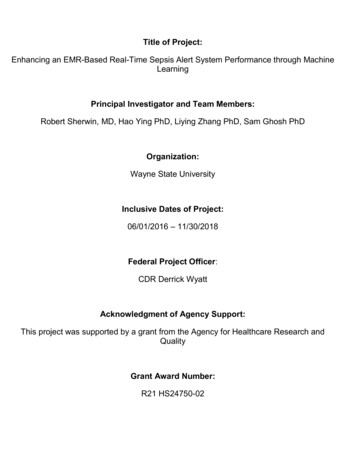
Transcription
Title of Project:Enhancing an EMR-Based Real-Time Sepsis Alert System Performance through MachineLearningPrincipal Investigator and Team Members:Robert Sherwin, MD, Hao Ying PhD, Liying Zhang PhD, Sam Ghosh PhDOrganization:Wayne State UniversityInclusive Dates of Project:06/01/2016 – 11/30/2018Federal Project Officer:CDR Derrick WyattAcknowledgment of Agency Support:This project was supported by a grant from the Agency for Healthcare Research andQualityGrant Award Number:R21 HS24750-02
ABSTRACT: (250 words maximum)Purpose: The aim of this project was to enhance an existing clinical decision support (CDS) tool using artificialintelligence (AI) techniques and implement it in our electronic health record (EMR).Scope: We have an existing sepsis related CDS, Sepsis-Alert (SA). The objective of this study was to report thedevelopment, implementation and performance of a novel knowledge-based AI enhanced sepsis related CDS,Intelligent Sepsis-Alert (ISA).Methods: The performance of SA was reviewed, and errors analyzed for opportunities to revise the model.Patients were partitioned into 14 separate risk groups and variables’ thresholds were optimized using a geneticalgorithm. The model was tested in consecutive retrospective cohorts of ED patients and then integrated intoour hospital’s EMR. ISA was then optimized and calibrated while functioning in the live EMR environment. Itsperformance was assessed using a 3-month sample of patients using ICD-10 coding as the gold standard forsepsis.Results: The final model consisted of 12 variables and partitioned patients into 14 groups. The performance inthe derivation phase resulted in a sensitivity, specificity and positive predictive value (PPV) of 83.3%, 91.1% and89.7% without and 90.9%, 90.9% and 90.3% following partitioning. The mean and median time to identify sepsiswas 68.9 72.3 and 46.9 minutes respectively. In live validation the sensitivity was 77.8%, the specificity was99.5% and the PPV was 57.3%.Conclusion: Our novel computer based CDS alert resulted in moderate sensitivity while minimizing resulting falsepositives. Partitioning patients into groups based on demographic features improved performance.Key words: artificial intelligence, sepsis, electronic health record, clinical decision support
PURPOSEOur primary hypothesis was that Intelligent Sepsis Alert (ISA), an artificial intelligence enhanced version of thecurrent Sepsis Alert (SA) would attain a sensitivity of at least 90% and increased positive predictive value of over60%. The potential impact of this project is profound whereby death and morbidity could be greatly reduced whilesimultaneously decreasing alert fatigue that plagues current sepsis clinical decision support (CDS) tools. Theprimary objective of the study was to develop ISA into an accurate, understandable and reliable CDS model thatwill operate autonomously in the electronic medical record (EMR) with the functionality assist clinical staff toidentify emergency department (ED) patients with sepsis in real-time. The secondary objectives assessed thefeasibility and performance of partitioning of the patients into risk strata for sepsis and optimization of the modellogic specific to the individual separate risk strata.SCOPESepsis is common in the U.S. It represents a healthcare epidemic that afflicts over 750,000 people annually.1 Itrepresents a host’s dysfunctional response to infection and includes a spectrum of disease severity from mild(sepsis) to the most severe (septic shock).2,3 Sepsis is expensive and costs approximately 16.7-20.3 billionannually and represents over 5% of total hospital costs in the U.S.1,4-6 Its incidence is increasing by 1.5% peryear and hospitalizations for sepsis increased from 143 to 243 per 100,000 persons between the year 2000 and2007.1,7 Sepsis is a national and international priority as demonstrated by the Surviving Sepsis Campaign (SSC)who strongly recommends early intervention and the Center for Medicaid and Medicare Services (CMS) whoestablished sepsis as a core quality measure in 2015.8 9-11Sepsis kills at a case fatality rate of 25% but despite this its recognition is challenging due to the heterogeneityof patients who may manifest a wide array of clinical presentations.11-13 It is clear, however, that if sepsis patientsare identified early and accurately, then delivering appropriate antibiotics and resuscitation will improveoutcomes and resource utilization.1,14 Unfortunately, significant barriers are common among nurses andclinicians with regards to both the recognition of sepsis and the urgency to delivery prompt care.15,16 Expeditious,accurate recognition and intervention has been cited as being by far the biggest barrier to compliance.17 Thoughthe diagnostic criteria for sepsis appear relatively straightforward, the literature illustrates that sepsis is actuallya diagnostic challenge and it is well documented that physicians commonly under-detect sepsis. 18,19 A majorcontributing factor is that many septic patients may initially present without organ dysfunction or evidence ofshock and only develop these during their ED stay, making early clinical recognition challenging.12,20,12,21Computerized CDS programs are now commonly available to assist with sepsis screening within the EMR.However, they are often built on rudimentary logic that are applied indiscriminately to patients no matter howdifferent they are. Furthermore, many were designed for ICU or medical wards and only a few were tailoredspecifically to the ED in the initial crucial hours of patient presentation when clinical data is relatively scant.22 Thereported sensitivity of these CDS software is 40-60%, with positive predictive values of 20%-54%.21,23 This lowaccuracy results in excessive false negatives, leading to delayed care in unrecognized sepsis patients and alertfatigue secondary to excessive false positives which desensitizes caregivers to all alerts.24One major limitation of the existing alert system in our hospital system and all other sepsis CDS tools in theliterature is that they lack any mechanism to learn from its past erroneous sepsis screening decisions and mayrepeat the same mistakes again and again on new patients. Another major limitation of all the CDS tools forsepsis, including our SA, is that the numbers of decision rules and variables in the rules are fixed, so are thenumber of intervals and the interval terminals that divide the range of each variable. Consequently, that meansthat all the patients are treated in the same way regardless of their age, gender, comorbidities or other factorsThe PI and engineering Co-I of this proposal collaboratively developed a CDS software named Sepsis-Alert (SA),which has been operating in our Cerner MillenniumTM EMR since October 2014. Sepsis-Alert was speciallydesigned to identify sepsis in ED as early as possible and uses sepsis specialist’s decision rules to calculate ascore based on vital signs, labs, demographics, and nurse assessments. It delivers an automated alert messageto a dedicated pager and email accounts when the score satisfies pre-determined criteria. Our analysis of over
25,000 cases shows that SA has a sensitivity and specificity of 80.3% and 98.6%, respectively, and a positivepredictive value of 20.4% for identifying adult sepsis patients in the ED.We proposed to substantially improve SA through such artificial intelligence techniques as fuzzy logic (forhandling ambiguity and uncertainties) and genetic algorithms (for optimizing parameters). The proposedinnovative software, named Intelligent Sepsis-Alert (ISA) will continuously monitor the EMR of every ED patientto identify patients likely to have sepsis. The ISA (1) assigns the patient to a category based on his/hercharacteristics, (2) apply decision rules, variables and other parameters of that patient category to compute ascore, and (3) use the score to make a sepsis alert decision and notify a health care provider in real-time.Review of the original Sepsis-Alert. The primary goal of the Sepsis-Alert was to identify ED patients highly likelyto have sepsis, severe sepsis or septic shock within the initial 6 hours of arrival and while still in the ED. Itsdevelopment and implementation were funded by Blue Cross Blue Shield of Michigan Foundation in a previousgrant. The basic logic rules were initially provided by sepsis experts and supported by the literature. A group oforiginal decision-making rules was provided from the expert physicians as a basis for the decision-making basedon the variables selected for inclusion (Table 1).CriteriaIf either RR 23 OR HR 110T 38.3WBC 15.0 or Bands 5%Points111Comment(2 points if combined with one of thecritical conditions or Age 75 years)(2 points if combined with one of thecritical conditions or Age 75 years)Lactate 4.03Critical condition(If any: ESRDa or2bNH resident or HIV or SBP 90)Age 75 years1Table 1: Sepsis-Alert logic. Alert delivered for any score of 2.a – end stage renal disease; b – nursing home.Nursing home residents presenting to the ED for care have a high prevalence of sepsis which is why this wasincluded as one of the variables. Unfortunately, in our EMR there is no unique and abstractable data pointavailable to easily identify these patients. This is the primary reason for including Schimdt’s Fall Risk (SFR), aroutine nursing assessment, in the model as a surrogate marker for patients who are likely nursing homeresidents. SFR assessment is required nursing documentation by ED nurses and is performed multiple timesdaily for inpatients. The responses are discreet and assess four elements of the patients’ physiologic status,two of which (Mentation and Mobility) were used. For purposes of these models, any patient with a ‘Mentation’of ‘Confusion at all times’ or ‘Comatose, unresponsive’ plus a ‘Mobility’ of ‘unable to transfer or ambulate’ wasconsidered a nursing home patient or a nursing home patient equivalent. The kappa statistic between theSchmidt’s Fall Risk and nursing home status (from manual chart review) was 0.85 in a subset of patients,providing a strong level of confidence in its validity.METHODSRule Modification Phase. The initial development of ISA was based upon SA and its historical cases reviewingfor errors and opportunities to improve. We took a random sampling of the charts from the live-production andreviewed 1,000 false negative and false positive charts to identify major themes and root cause of errors. Errorswere codified based on likely source: Coding error – ICD codes not consistent with charted diagnosisData entry – Error with respect to vital sign documentation or documentation of co-morbiditiesDocumentation – Documentation with respect to physician chartingLogic – Error attributed specifically to model’s logic.Intelligent Sepsis Alert (ISA) was designed to be significantly enhanced version of SA and was designed tooperate in similar fashion. The same EMR and initial EMR inputs and variables used by SA were used by ISA.The ISA logic was then modified accordingly as appropriate in response to the review of the errors. Each of the
continuous variables’ thresholds were then optimized to maximize sensitivity and positive predictive value foridentifying sepsis in our derivation cohort.ISA functions in real-time in conjunction with the live DMC EMR environment and constantly monitors patients.It issues an electronic alert to the healthcare providers once it finds that a patient satisfies the sepsis screeningcriteria. Only one alert is permitted per patient – ISA stops monitoring a patient once an alert has been issuedfor him/her. Substantial alert performance gain is expected for ISA owing to the three new components in Fig.1, which will (1) classify patients into categories, (2) apply different sets of decision rules, variables and intervalsfor variables to different categories of patients, and (3) apply a different threshold to accumulated sepsis pointsfor different patient category. The categories, decision rules, variables, intervals for variables and thresholds canall be adjusted offline.As shown in Figure 1, there are seven blocks in the Intelligent Sepsis-Alert which are coded in two colors. Threeare in white, which represent new components that do not exist previously. The remaining four blocks are in blueand their functions are very much like those in SA described above.DMC EMRbed-side clinicalmeasurementslab o sePharmacyDatabasenewpatient’sFuzzyRule-Based categoryPatientClassifierSepsis ScoreCalculatorsepsisscoredecision rules,variables, andintervals forthe new patientDecision Rules, Variables,and Variables’ Intervals forDifferent Patient lessTransmitters(e.g., pagers)sepsisalertthresholdfor the newpatientSepsis ScoreThresholds forDifferent PatientCategoriesFigureStructurethe originalSepsis-alertof the newIntelligent-Sepsissystem.Fig. 1. 1:Structureof ofReal-TimeAlertModule ofandthe proposedintelligentsepsis alertsystem.Function of current Sepsis-alert.Proposed new function.Adjustable functionPartitioning. At present, identical variables, intervals for variables, decision rules and sepsis score threshold ofSepsis-Alert are indiscriminately applied to all patients regardless of age or co-morbidities. We addressed thisweakness by partitioning patients into patient categories according to patient attributes and physician clinicalknowledge. The 12 original variables, intervals for these variables, decision rules and sepsis score thresholdused have delivered satisfactory clinical performance and were used as “initial conditions” and assigned to allthe patient categories. This means when ISA began operating, all the patient categories shared the same setting.Their settings, however, started to evolve and may become different over time through the optimization process.The 12 variables original variables served as input to ‘Fuzzy Rule-Based Patient Classifier’, which is a newcomponent. This component is needed because one diagnostic difficulty as described above in the Significancesection is that due to the high heterogeneity of sepsis, the implication of each of the variables may be stronglycorrelated to the context (demographics, co-morbidities, etc.) of the patient. Sepsis-Alert and all other similarsystems treat all patients uniformly regardless of their age, comorbidities or other factors, which is counterintuitiveto the thought process of a healthcare provider.One optimization mechanism is ‘Genetic-Algorithm-Based Optimizer’ for ‘Decision Rules, Variables’ Intervals,and Thresholds’, which optimizes decision rules, variables’ intervals, and sepsis score thresholds of differentpatient categories though guided stochastic search conducted by a genetic algorithm. This was performed onecategory a time and covered all patient categories. An objective function was established, and it was the samefor all the categories. It was used by the genetic algorithm to evaluate fitness of a new generation of theadjustable parameters in ISA. The function penalized occurrences of false positives and false negatives whilerewarding correct decisions (e.g., a weighted sum function). To make the optimization process more efficient,
we add constraints for ‘GA-Based Optimizer’ which set parameter search boundaries for the genetic algorithm.Decision rules and thresholds were optimized through improved point assignment.During the optimization operation using historical cases, all the adjustable parameters were varied by the geneticalgorithm within the constraints to minimize the objective function value (i.e., minimize the overall errors). Thewell-known elitism principle was adopted to ensure alert performance produced by a new generation is at leastas good as that attained by the previous generation. One constraint imposed on the assignment is that theresulting rules must make clinical sense to the sepsis experts.Every patient category defined in the ‘Patient Classifier’ has its own sets of variables, intervals for variables,and/or decision rules that are most suitable for the patients in the category. These sets are stored in the ‘DecisionRules, Variables, and Variables’ Intervals for Different Patient Categories’ component, which employs patient’scategory to find the category’s corresponding decision rules, variables, and variables’ thresholds. The thresholdsare stored in ‘Sepsis Score Thresholds for Different Patient Categories’.The variables, intervals for variables, and decision rules corresponding to the patient’s category is sent to ‘SepsisScore Calculator’. The Calculator will use them to compute a sepsis score in a way similar to Sepsis-Alert does.The score will then be compared by ‘Decision Maker’ to a threshold specific to the patient category to translatethe score into a Yes or No “sepsis screening decision.” If decision is ‘Sepsis No’, then no alert will be issued,and the decision will not be saved in the EMR. On the other hand, if decision is ‘Sepsis Yes’, then the decisionwill be saved in the EMR and will automatically send an electronic alert email. No work was needed on this partof the system as it is presently functioning clinically.Retrospective Derivation Phase. In this phase, a retrospective data set of initially 2,000 case (50% sepsis and50% non-sepsis) was used to further refine the ISA. The initial 1,000 adult ( 18 years) cases were selectedfrom the EMR based on ICD-9 codes and were age matched with 1,000 adult age-matched admitted patients ascontrols. Each patient chart in this cohort was reviewed to for the presence of sepsis based on clinical criteria(Sepsis 2.0 – SIRS based criteria). Each case was then recategorize as sepsis (Yes No) based on the chartreview. The performance of the model was then assessed based on partitioning (with vs. without), by optimizingthe variables individually in each category versus optimizing the overall score (and keeping the variablethresholds set). Errors were reviewed by point accruement, and patient group and adjustments made to themodel accordingly. Finally, as a benchmark comparator, using MATLAB Classification Learner we comparedperformance of this model to 23 separate dedicated machine learning techniques.Retrospective Test Phase. In this phase, a larger retrospective data set which included one year of sepsis casesselected, now based on ICD-10 codes and was matched with a random one year sample of non-sepsis casesadmitted to the hospital from the ED for a target cohort size of 8-10K. Due to the size of this sample, individualchart adjudication was not possible and therefore the ICD-10 coding was used as the gold standard for diagnosis.Errors were again reviewed by point accruement, and patient group and adjustments made to the modelaccordingly. In this phase, multivariate logistic regression was used to determine the value of ISA model’svariables and to explore for potential additions.Implementation Phase of ISA into DMC’s EMR. Drs. Sherwin and Ying have worked successfully with the DMCInformation Technology (IT) department and had full support and cooperation with this project. The process ofimplementation included meetings and conference calls with the DMC IT director and the lead softwareprogrammers to establish the statement of work, a progression plan of tasks, and criteria for completion.Additionally, approval at the system level included conference call meetings with both local and national hospitalsystem leadership. Regular programming meetings were attended by the IT leadership; the project programmersaddressed any programming issues. The initial “build” occurred in the EMR test environment, which representsan operational clone of the live environment with the exception that it only contains fictional test patients.Components of ISA were then assessed individually first, followed by the entire module, within the test EMRenvironment to ensure they functioned properly.Due to the prior experience, we have first-hand knowledge on the strengths and shortcomings of EMRprogramming environment with regard to adding a new user-defined function. We have taken advantage of thisknowledge and designed ISA in such a way that it will be relatively easy to be implemented into the EMR. Our
approach is to use lookup tables. Actually, all three new functions in Fig. 1, namely “Fuzzy Rule-Based PatientClassifier” (it is converted to Patient Category Lookup Table), “Decision Rules, Variables, and Variables’ Intervalsfor Various Patient Categories,” and “Sepsis Score Thresholds for Different Patient Categories” can be, and willbe, implemented as multi-dimensional lookup tables. “Sepsis Score Calculator” is a basic calculator while“Decision Maker” is just a comparator. Therefore, there is no complex algorithm and all the operations are simple.Thus, as far as the implementation is concerned, ISA can be considered as a relatively straightforward upgradefrom Sepsis-Alert. The expected timeline for the program implementation was few weeks.Live Validation Phase. In the live validation phase, the final data for prospective analysis included all adultpatients ( 18 years at time of visit) seen in the ED of Sinai Grace hospital (Detroit, Michigan) between(inclusive) the dates of August 16th, 2018 and October 31st, 2018. The gold standard used for sepsis in thephase was based on ICD-10 coding. The model’s overall performance with respect to partitioning and identifyingsepsis patients were reported. As in previous phases, error checking was performed to identify route causes.RESULTSRule Modification Phase. This phase began by assessing and building upon our original model, Sepsis-Alert,which was already running in the EMR of the Detroit Medical Center since 2014. We reviewed 1,000 of randomlyselected cases under the SA to determine thematic root causes of errors for potential correction.In the review of the errors, several false negatives were attributed to patients who were at high sepsis risk dueto reasons other than what SA defined as nursing home equivalence. Upon reviewing the Problem Lists availablein the EMR, we also included patients with paraplegia and multiple sclerosis. This can be a complex process tobe inclusive of all the possible data points as there are multiple results that indicate the presence of various comorbidities of interest. We ultimately decided on including the following co-morbidities: end stage renal disease(13 diagnoses in Problem List), paraplegia (18 diagnoses), decubitus ulcer (8 diagnoses) while there is only onethat represents the presence of multiple sclerosis. Therefore ‘Nursing home equivalence’ in addition to the SFRbased definition, ISA now included any patient with evidence multiple sclerosis, decubitus ulcer or paraplegia ontheir EMR Problem List in the NHE category. Historically sepsis and infection are a very common reason thatresult in ED visits for NH residents. As such we tested a stand-alone rule that would count all NHE patients assepsis which resulted in poorer accuracy of the model. Therefore, the NHE variable remained only as a variableto categorize patients.We had also considered using either a history of sepsis or history of stroke as well, but ultimately decided againstit as the data revealed many of these patients actually had transient ischemic attacks (not a stroke) or the strokehistory being recorded was unverified and therefore unreliable. A history of sepsis also did not provide addedvalue beyond the comorbidities already being used. A history of HIV was utilized in the original SA rule, but wasremoved as it added no value to the model performance.The error review resulted in a deeper understanding of the patient types and characteristics that mimicked sepsisphysiology in the EMR. Two variable limits were established including ignoring any heart rate 170 (this isgenerally due to an arrythmia and not sinus tachycardia) and ignoring any lactate acid 10 (these are moreoften due to cardiac arrest then sepsis). For the variable thresholds, the model would still consider the patientbut would not use either variable if it exceeded the set limit.Common sepsis mimics (patients that often result in false positive alerts) include victims of trauma, diabeticketoacidosis, COPD, cardiac arrest and respiratory failure. Based on the review, several new rules wereconsidered. Patients with higher troponins tended to have primary diagnoses of cardiac ischemia and not sepsis.The investigators considered excluding patients with troponins above a certain threshold from the logic howeverit is not uncommon for patients with septic shock to demonstrate global ischemia and result in elevated troponinsas well. We also considered excluding any patient with elevated glucose values. We considered manuallyadjusting the temperature threshold in response to the error review but elected to allow this part of the model tobe informed primarily by the genetic algorithmic optimization. Additional considerations for model modificationthat were not ultimately implemented included extra weighting for extremely elevated WBC’s, including patients
on active chemotherapy, extra weighting for the presence of multiple co-morbidities and adding history ofintravenous drug use to the list of co-morbidities of interest.We determined that a number of false positives were actually major trauma patients who had similar physiologicderangements as sepsis patients. It was discovered that one data element almost universally present in allmajor trauma evaluations, but not in most sepsis evaluation is the ordering or a serum alcohol level. In exploringthis, we considered eliminating trauma patients using alcohol levels. Though it was very uncommon for patientswith alcohol levels 150 mg/dL to be adjudicated with sepsis, alcohol levels did not ultimately result in anysignificant reduction of false positives related to major trauma. Therefore, it was decided not to implement thealcohol rule.Retrospective Derivation Phase. Our goal was to build the ISA model based on cases individually adjudicatedby chart review by a sepsis expert. The reason for this is that ICD coding (in this case ICD-9) can be occasionallyinaccurate. This phase included a cohort of patients with – originally 1,000 septic patients from a five-year periodand a randomly selected cohort of non-sepsis patients over the same time period.Following elimination of duplicate charts, and excluding children, the final number included a total of 1,887patients (912 septic and 975 non-septic). These charts were selected based on ICD-9 codes which were thestandard at the time. When this grant was submitted, the standard was still the SIRs based criteria andsuspected or confirmed infection as oppose to SOFA based criteria (Sepsis 3.0). Sepsis 3.0 is still not universallyadopted and at the time to this writing and CMS still adheres to the SIRS based criteria for sepsis diagnosis.Charts were individually adjudicated for presence of sepsis as a primary or secondary condition for presentationto the hospital. This included suspicion of an infection plus two SIRSs criteria within the initial 6 hours. Throughindividual chart review, we determined several sources of errors leading to a significant proportion of falsepositives and false negative cases. This included modification of variable thresholds and expansion of criticalconditions that put patients at risk for sepsis: specifically including active multiple sclerosisand aparaplegic state. Eighty-nine patients (4.7%) were recategorized base on this review; either from Sepsis Yes toSepsis No or the reverse.Partitioning Phase. Partitioning of the patient’s cohorts was done based up known risk factors for sepsis andmachine intelligence. Some of these were included in the original model and some were newly introduced. Themajor risk themes include patients who are bed bound, residents of nursing homes and patients with indwellingcatheters for chronic hemodialysis. These patients were identified using the ‘Problem List’ in each patient’sEMR. The Problem List pulls data and diagnoses from several sections of the EMR and compiles acomprehensive list of diagnoses that apply to each patient. The disadvantage is that this relies on human inputand accuracy of the data and may not include patients new to the system or with new diagnoses for which thedata has no yet been input into the EMR. Furthermore, temporary diagnoses (short term dialysis, for example)may result in a false indication that a patient is receiving ongoing chronic dialysis if this is not manually removedfrom the Problem List.Patients were then partitioned in 12 separate groups based on age and sepsis risk factors (Table 2 andthresholds of each variable was set to a default prior to optimization. Due to group size, we split two into twoseparate groups and therefore ended up with a total of 14 groups. Using the genetic algorithm, thresholds wereoptimized across each of the fourteen groups to prioritize sensitivity, first, followed by positive predictive value(Table 3).
Step I: Grouping VariablesPatientGroupAgeNHEa1 60Yes2 603Step II: Predictor VariablesV1 (RR)V2 (HR)V3 (T)V4(WBC)V5 (Bands)V6(Lactate)V7 0010%4.03.0 60NoYes2311038.015,00010%4.03.04 038.015,00010%4.03.09 79YesYes2311038.015,00010%4.03.010 79YesNo2311038.015,00010%4.03.011 79NoYes2311038.015,00010%4.03.012 79NoNo2311038.015,00010%4.03.0ESRDTable 2: Group categorization based on age, nursing home and dialysis. Additional variables list the current thresholdsthat will be modified in Specific Aims 2 and 3, resulting in individualized group logicStep I: Grouping VariablesPatientGroupAgeAllNHEaESRDDefault valu
annually and represents over 5% of total hospital costs in the .1,4-6 Its incidence U.S is increasing by 1.5% per year and hospitalizations for sepsis increased from 143 to 243 per 100,000 persons between the year 2000 and 2007.1,7 Sepsis is a national and international priority as demonstrated by the Surviving Sepsis Campaign (SSC)
